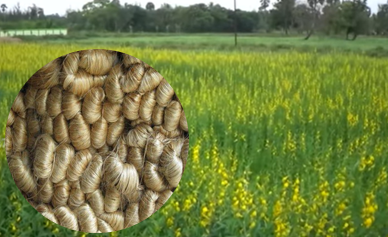Jute

Jute, popularly known as the Golden fibre of Eastern India, is the second important natural fibre crop after cotton. Jute and mesta crop are together known as raw jute in trade and industry due to their similar usage.
Commercial jute cultivation is primarily confined to the Indo-Bangladesh sub-continent while China, Thailand, Myanmar, Indonesia, Brazil and Nepal are other major jute growing nations of the world. C. olitprius and C. capsularis are the two main species of Jute grown in India besides few other wild species. According to the National Jute Board, India is the world’s largest producer of raw jute and jute goods, accounting for more than 50% and 40%, respectively, of global production.
Raw jute plays an important role in India’s economy. This crop of hot and humid climate is exported as goods and also as a raw fibre. Amidst the growing concern about environmental pollution, Jute has regained its importance which was challenged by the introduction of synthetic fibre in the late sixties and early seventies.
Jute productivity has more than doubled from 11 quintal per hectare since independence to 22.12 quintal per hectare in 2010-11 and the total production of raw jute in the country is about 10 million bales of 180 kg each. Currently, Jute acreage is around 8 lakh hectares in the country. With its insignificant share (0.68 million hectares) of the country’s total arable land area, Jute plays a predominant role in the country’s economy by generating employment and earning crucial foreign exchange reserves. Around 1.7 lakh workers are directly employed in jute mills while around 2 lakh are associated with allied sector and tertiary activities.
Raw jute was originally used only as a source of raw material for packaging industries. But, it has now emerged as a versatile raw material with diverse usage in various industries (textile, paper, building and automotive industries), as soil saver, as decorative and furnishing materials, etc. Being a bio-degradable and annually renewable source, raw jute is recognized as an environment-friendly crop which helps in maintaining the environment and ecological balance. Jute is in great demand due to the cheapness, softness, strength, length, lustre and uniformity of its fibre.
Ideal Soil and Climate
Jute requires a hot and humid climate with temperatures fluctuating between 24 degree Celsius to 38 degree Celsius. Minimum rainfall required for jute cultivation is 1,000 mm. Alternate sunshine and rainy days facilitate jute growth while river basins or alluvial or loamy soils are most suitable for growing jute.
This rainy season crop is sown between the months of March to May, according to rainfall and type of land. The crop is harvested between July and September depending on the sowing timings.
Important regions/ zones
Jute is mainly grown in the eastern and north eastern India while mestais cultivated in different agro-climatic conditions in almost all over the country. The crop can be grown in low, medium and high land situation, both moisture stress and water stagnating condition. White Jute is grown in low land areas while Tossa Jute is preferred in medium and high land areas.
Major Jute Growing States
The cultivation of jute is primarily confined to the eastern and north-eastern states viz., West Bengal, Bihar, Assam, Tripura, Meghalaya, Nagaland and Odisha. West Bengal accounts for nearly 50% of raw jute produced in India.
Jute – All India Area and Production
|
|
2018-19 |
2019-20 | 2020-21 | 2021-22 | 2022-23 |
| Area (Million Hectares) |
0.7 | 0.6 | 0.6 | 0.6 | 0.6 |
| Production (Million Bales)^ |
9.8 | 9.8 | 9.4 | 10.1 | 9.3 |
Source: Directorate of Economics & Statistics, Department of Agriculture and Farmers Welfare.
^ Bales of 180 Kgs, 2nd Advance Estimates of Production of Oilseeds & Commercial Crops for 2023-24
Jute Exports
India exports jute and jute products mainly to the USA, the UK, Australia, Belgium, Egypt, Germany, Italy, Japan, Saudi Arabia, and Turkey. During 2021-22, the United States was the leading importer of jute manufacture including floor covering, from India, with a value of US$ 118.3 million, a 26.3% increase over the previous year. It was followed by the UK and Germany, with exports valued at US$ 27.8 million and US$ 22.3 million, respectively.
The top five destinations for jute diversified product exports from India are the USA, France, the UK, Netherland, and Spain.
Raw Jute & Jute Goods Export from India
|
|
2018-19 |
2019-20 | 2020-21 |
2021-22 |
2022-23 |
|
Value |
2,273.27 | 2,423.85 | 2,740.46 | 3,785.87 | 3,510.48 |
Source: Department of Commerce, Ministry of Commerce & Industry, Government of India
https://ijma.org/export-from-india.html
References:
- Handbook of Agriculture, Indian Council of Agricultural Research, August 2021
- Rajya Sabha, Unstarred Question No. 3477, Ministry of Textiles, March 25, 2021
- Pocket Book of Agricultural Statistics, Directorate of Economics and Statistics, 2020
- https://farmer.gov.in/cropstaticsjute.aspx
- https://www.agrifarming.in/jute-cultivation
- https://www.jute.com/about-us/faq
